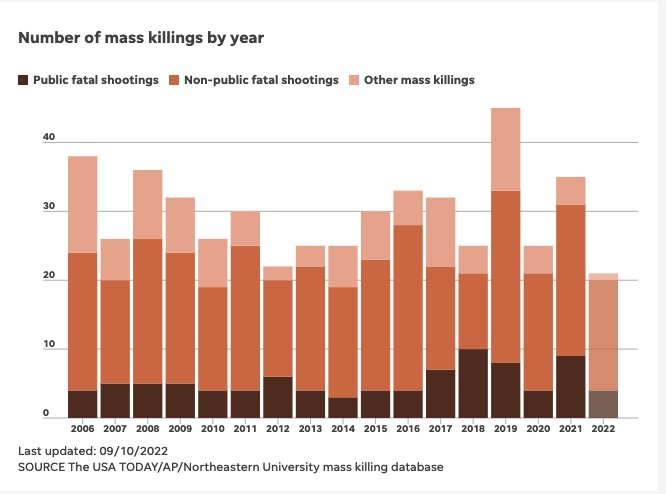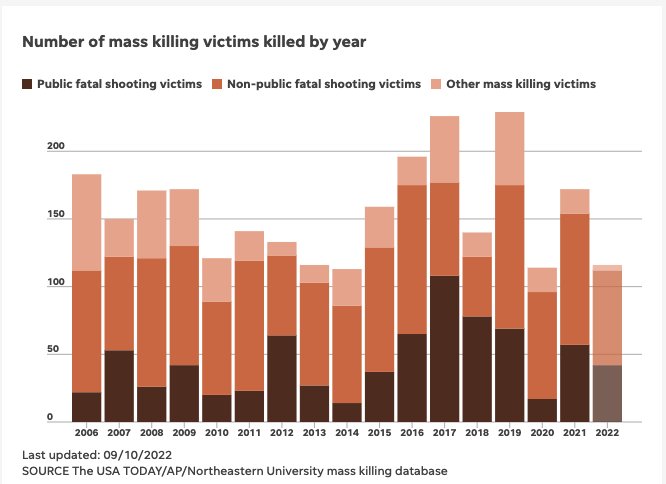Victoria Holmes | for Editor & Publisher
A joint project by the Associated Press, USA Today and Northeastern University compiled one of the most comprehensive databases tracking mass murders in the US The database contains information on mass murders since 2006, including the number of victims, location and type of weapon. The project also includes an interactive timeline that allows users to browse through all the data. Josh Hoffner, the US news director for The Associated Press, said the data set can give reporters a context for how a mass killing might fit into the bigger picture.
“Say there's a murder, the database will be able to immediately tell a reporter, 'This is the twelfth mass murder, compared to previous years that were higher or lower.' Or, 'This is the number of people who died in mass murder,' that momentary kind of textual paragraph or data shows how that news event fits into the bigger picture,” Hoffner said.
The mass murder tracker previously existed under USA TODAY, but had languished over the years. Hoffner said the database project was revived after a former data editor, Megan Hoyer, brought together various stakeholders to revive the project. This happened around the same time as the 2019 El Paso Walmart shooting and other mass murders. Hoffner said his team sees this data set as a valuable public service.


Access this “E&P Reports” Vodcast on how the Washington Post uses data journalism to investigate police shootings.
“It was a time when there was a lot more public interest in mass murder. And we thought, you know, reviving the database, making it widely available to AP clients and also to the public would be the right thing to do in light of all the attention that mass murders have been getting,” Hoffner said.
Professor James Alan Fox is the Northeastern University researcher working on the joint project. Fox has studied mass killings for 40 years and said private gun violence accounts for a much larger percentage of mass killings in the U.S., even though major mass shootings tend to make headlines. Trends show that there has been no rise in mass killings.


Professor James Alan Fox is the Northeastern University researcher working on the comprehensive database tracking mass murders in the US
“Over the last 15 years, there really hasn't been an increase. fear has increased. And that has a lot to do with the amount of attention they get, not only in traditional media but also in social media. So this is an epidemic of fear, but I wouldn't say it's an epidemic of mass murder,” Fox said.
Fox notes that there has been an increase in high-casualty cases. He also highlighted the confusion between mass murders and mass shootings, citing an article he wrote to reporters clarifying the difference between the two.


“The opening line was, 'Why do so many journalists and columnists cite the statistics of hundreds of mass shootings a year using the Gun Violence Archive, and then every example they give to illustrate is catastrophic mass murder?' Do they want to scare people? Because that's the problem when you combine death and injury,” Fox said. “Most people who are injured would rather be injured than killed. It's not the same,” he added.


Another review by Fox raised concerns that the face or name of the killer was not mentioned. That's part of it “no movement of ill repute,” which asks media organizations not to publish such information to prevent violent copying from occurring. Fox said that from his perspective as an investigator, he doesn't think people are inspired by seeing the shooter's face in the newspaper.
“It's the act, not the actor, that like-minded people draw and admire,” Fox said.
Fox acknowledges that there is a line that can be crossed where the media will give every detail about the shooter, citing the Las Vegas shooter as an example when people could even read what the shooter ate that night.
So what does this mean for newsrooms? More data is always useful, and few people would argue that this particular data is inherently harmful. Overall, the database is complete. Those looking to research the topic or inform the public will find a wealth of valuable information available in one location. The database is updated daily and the work will continue. Fox said adding information such as mental health status could be beneficial in the future.




